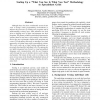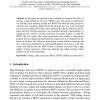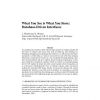127 search results - page 3 / 26 » Do You See What Eyes See |
VL
1999
IEEE
13 years 10 months ago
1999
IEEE
Although there has been considerable research into ways to design visual programming environments to improve the processes of creating new programs and of understanding existing o...
VL
1998
IEEE
13 years 10 months ago
1998
IEEE
We introduce visual graphs as an intermediate repren between concrete visual syntax and abstract graph syntax. In a visual graph some nodes are shown as geometric figures, and som...
ICSE
1998
IEEE-ACM
13 years 10 months ago
1998
IEEE-ACM
Form-based visual programming languages, which include commercial spreadsheets and various research systems, have had a substantial impact on end-user computing. Research shows, h...
EUROITV
2008
Springer
13 years 7 months ago
2008
Springer
In this paper an experiment was conducted to measure the effect of framing a high definition television (HDTV) clip. One group of participants was told they were watching a brand n...
VDB
1998
13 years 7 months ago
1998
Any graphical user interface (GUI) requires large amounts of complex metadata for the layout of windows and menus, their style and behavior, their bindings, etc. Designing, debugg...



